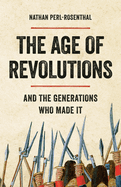
In The Age of Revolutions: And the Generations Who Made It, historian Nathan Perl-Rosenthal thoughtfully reevaluates the seven decades between 1760 and 1825 that broke empires and incubated new ideologies. In Peru, an indigenous rebellion struggled to escape from the Spanish empire. In the American Revolution, a colony broke free from the British. In Haiti, a series of competing factions gained independence from France but struggled to agree on what the new republic should look like. And in Paris: revolution--eventually.
Perl-Rosenthal (Citizen Sailors) builds a compelling case for how these revolutions, parts of an interrelated system, influenced one another, rather than treating them as discrete units, as they're often studied. He probes in-depth how the same set of cultural forces, such as class and racial differences, fueled them. These differences, and the accompanying stratification of privilege, at times hobbled the progress achieved, especially within the first generation of the revolutionary time periods Perl-Rosenthal covers. "The hierarchical reflexes of the first-generation revolutionaries, acting as so many barriers between class and racial groups, made it difficult for them to form sustained political movements."
The author supplements these histories with engrossing stories of the people involved. A Peruvian nun gained and wielded her clerical power, sparring with Spanish governance. A man born into slavery attained freedom and went on to lead the first incarnation of the Haitian Revolution. The book also follows John Adams and Napoleon and their well-documented influences on the events of the time.
The Age of Revolutions presents intriguing anecdotes of individuals both famous and lesser-known, plus an enlightening analysis of how to consider each revolution in a more global context. --Carol Caley, writer

